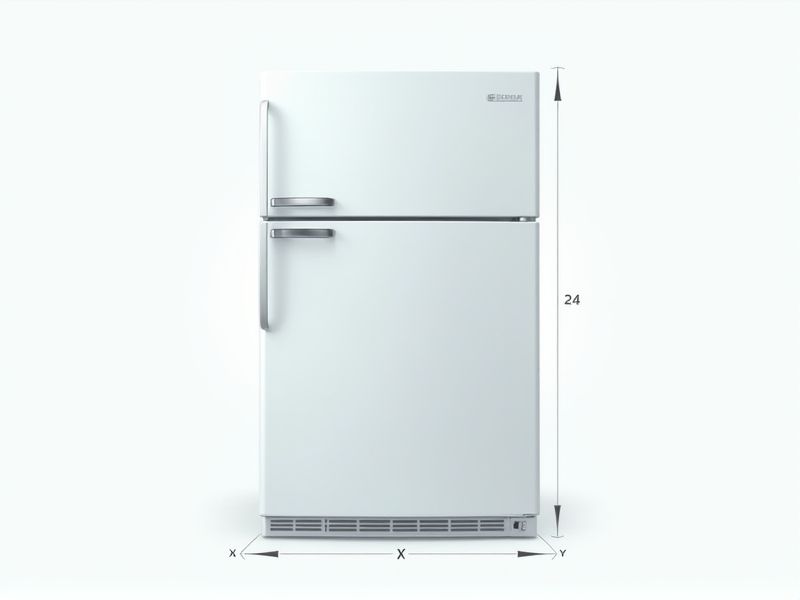
Knowing the standard dimensions of a fridge can help ensure it fits seamlessly into your kitchen layout. Most full-size refrigerators typically measure between 30 to 36 inches wide, 67 to 70 inches tall, and 29 to 35 inches deep, including the doors and handles. Before purchasing, it's helpful to measure both your available space and the pathway leading to the installation area to avoid any surprises on delivery day. Always allow for extra clearance around the fridge for ventilation and easy door opening, which improves performance and longevity.
Height
The standard height of a refrigerator typically ranges from 65 to 70 inches, accommodating various kitchen designs and user preferences. Most residential fridges are designed with a depth of around 30 to 34 inches and a width varying between 28 and 36 inches. This height ensures optimal storage space while allowing for easy access to the top shelves. When selecting a fridge, consider your kitchen's layout and your height for comfortable use and accessibility.
Width
The standard width of a refrigerator typically falls between 28 to 36 inches, with the most common size being 33 inches. This dimension accommodates most kitchen layouts, ensuring optimal airflow and seamless integration with cabinetry. For specialized needs, compact refrigerators can be as narrow as 24 inches, perfect for small spaces or apartments. When selecting a fridge, consider the door swing and clearance, as these factors affect accessibility and overall functionality in your kitchen.
Depth
The standard depth for most residential refrigerators typically ranges from 28 to 34 inches, ensuring a balance between capacity and space efficiency. When considering depth, a counter-depth refrigerator is an optimal choice, as it aligns flush with your kitchen cabinetry, usually measuring around 24 to 26 inches. This design not only enhances the aesthetic appeal of your kitchen but also maximizes accessibility to stored items. Be mindful that the deeper models often provide larger storage capacity, accommodating more food and beverages to suit your household needs.
Capacity In Cubic Feet
Refrigerators vary widely in capacity, typically ranging from 10 to 30 cubic feet. For a small household of one or two people, a fridge with around 10-15 cubic feet is often sufficient, while larger families may require 20-30 cubic feet to ensure ample storage for groceries. Your choice should also consider the layout, as top-freezer models usually provide more usable space than side-by-side configurations. It's crucial to assess your needs and kitchen space when selecting a refrigerator to maximize storage efficiency.
Door Size
The standard door size for most refrigerators typically measures around 28 to 30 inches in width and 66 to 70 inches in height. This sizing ensures a comfortable fit in typical kitchen spaces while allowing for easy access to the contents inside. For custom installations, be mindful of the refrigerator's depth, which usually ranges from 28 to 35 inches, to accommodate pre-existing cabinetry. Choosing a fridge with a door that opens fully can enhance your cooking experience and accessibility to stored items.
Shelf Dimensions
When choosing a refrigerator, shelf dimensions are crucial for maximizing storage efficiency. Standard shelf depths typically range from 24 to 30 inches, accommodating a variety of food items and containers. Height adjustments usually span about 1-2 inches, allowing you to customize space according to your preferences. Ensuring these measurements align with your kitchen layout can enhance accessibility and organization in your food storage.
Crisper Drawer Size
The crisper drawer size in modern refrigerators typically ranges from 15 to 20 inches in width, designed to optimize produce storage and maintain freshness. Many high-efficiency models feature humidity control settings, allowing you to adjust the environment based on the specific requirements of fruits or vegetables. A well-sized crisper drawer can accommodate up to 10 pounds of produce, ensuring that your groceries are organized and easily accessible. Consider a fridge with adjustable dividers, as they can help maximize the usability of the crisper drawer space.
Freezer Section Dimensions
The standard freezer section dimensions in most refrigerators typically range from 5 to 7 cubic feet, accommodating various storage needs. In terms of width, freezer compartments usually measure between 24 to 36 inches, while the depth generally falls between 20 to 30 inches, allowing for a balanced storage space. Height can vary significantly; however, many reach around 30 to 36 inches tall, fitting seamlessly into kitchen designs. If you seek a freezer that maximizes available space, consider models with adjustable shelving and bins designed to optimize every inch of storage capacity.
Clearance Space For Ventilation
Proper clearance space for ventilation is crucial for maintaining the efficiency and longevity of your refrigerator. Ideally, you should leave at least 1-2 inches of space on the sides and back of the appliance to ensure adequate airflow. This ventilation helps prevent overheating, which can lead to increased energy consumption by up to 15% if obstructed. A well-ventilated fridge not only optimizes cooling performance but also prevents potential mechanical issues, extending the lifespan of your appliance.
Adjustable Shelving
Adjustable shelving in refrigerators offers unparalleled versatility, enhancing storage efficiency and organization. Many models feature multiple adjustable shelves that can accommodate various container heights, promoting optimal use of space. Research shows that refrigerators with this feature can improve your food preservation practices by allowing better airflow and visibility. Consider models with easy-to-move shelves, as they can significantly increase your ability to customize the interior layout according to your needs.
